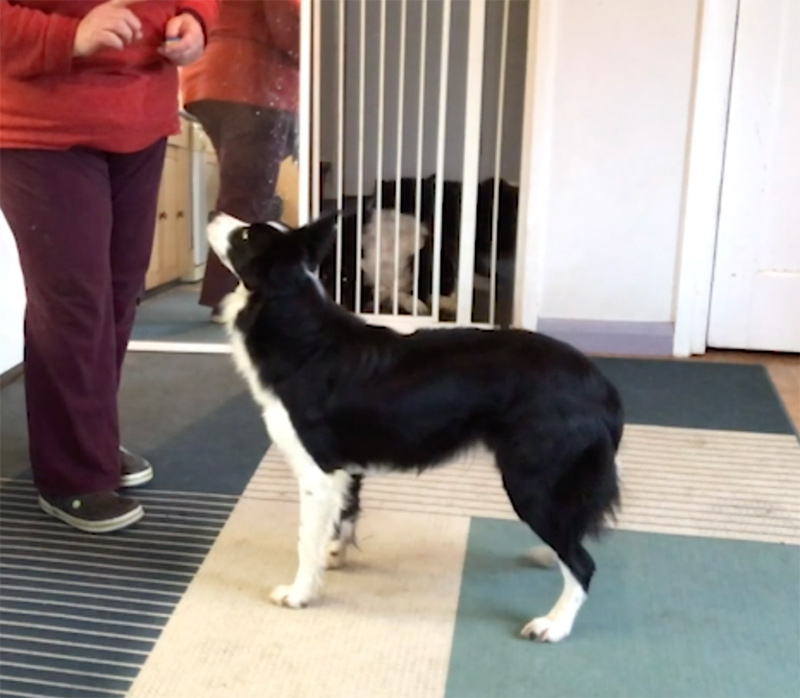Cue Seeking

Learning is a continually dynamic process and when food is involved this process naturally winds down as the stomach is full or the cupboard is empty. But if both conditions of a good appetite and a full treat box exist then learning is on the agenda.
The dog will undoubtedly be aware of the close proximity of food through the scent in the air. This will begin a process of enquiry, which we can see in their engagement in scenting the source of the food. When this engagement orientates to us, we will respond by collecting and then delivering a treat.
These two processes, our actions, become salient information to the dog. The collection predicts the delivery. Collection can serve as a marker or be preceded by a marker, but it should not be happening at the same time as the marker, otherwise a marker will become irrelevant.
If collection is your marker, you will lay down a foundation that limits behaviours to the dog being in a location where they can see the collection process. This will then exclude behaviours where the dog may be looking elsewhere, at a retrieve item, a jump, the approaching person. An audible marker is the most effective option, either verbal or a clicker.
Delivery usually focuses on the consumption of the reward, the eating of the food. By incorporating different delivery patterns: catching, chasing, we can include an element of play that increases the reward value and arousal, and we can utilise placement, where the food is collected by the dog, to strategically set-up the opening of the next, or repetition, of the behaviour.
- If the placement restricts movement, the dog is fed in a stationary location, then the next behaviour will begin at that location.
- If the dog steps away from that location to collect, then the next behaviour begins at that different location.
- If the dog travels several feet away then the next behaviour begins at some distance.
This gap between the collection and consumption and the begin of the next behaviour allows us to see the effect of the reward to the dog.
- Are they keen for more or just mildly interested?
- How do they enquire whether this pleasure is going to happen again?
- Do they run towards us or wait on the spot.
- How powerful and attractive is another reward? Does it override other events that are happening?
- How much energy is in the re-orientation to the food? Has this reduced or increased? A reduction may indicate a full stomach or mental fatigue.
Without allowing this space to be filled by the dog we restrict our view of the dog’s desire to continue. We can effectively mask what is happening and make misassumptions.
Strategic placement opens this window for use to evaluate the process of cue seeking.
Every behaviour is preceded by antecedents and it is the monitoring of these antecedents that give the dog relevant information to the opportunities available:
- An open hand as an antecedent can indicate tactile contact that results in more rewards.
- A verbal cue can indicate a known behaviour, a moving object can indicate an interaction.
- The person walking away can signify an end of the training session or evoke a desire to catch up and not be left behind.
The dog will be learning the relevance of thousands of different antecedents which may occur as single events or collective events. They will select those that in their experience give rise to opportunities for more food.
This process is cue seeking.
When the dog re-engages and become actively cue seeking we respond with the familiar cue. This will act as a reinforcer for cue seeking and open the avenue to reward.
Cue seeking behaviour should always be carefully monitored and changes noted.

Teaching Cue Seeking
Whether beginning with a young puppy, from the age of about 6 weeks, or an older dog the process always begins with establishing that what we wish to function as a reinforcer, is rewarding for the dog at this time.
We are looking for evidence that the food we give is pleasurable, and more food is attracting the learner. Fatigue and stress may reduce this appetite or attraction, or other events in the environment may require the dog’s complete focus that food seeking would interrupt. If the dog is engaged in watching another activity that may be an opportunity or threat, then at that time food is not their reward of choice – continuing to watch is.
The delivery of our first piece of food is our opening assessment of its value. It establishes the opening of the session, it will become our future cue that learning is beginning. We can precede the delivery with a deliberately choreographed interest in what we may have in the box, or what is hiding in our pocket or picking up a treat pouch.
Collection of the first treat should be observed by the dog, we can attract the dog with our own interest in this bounty.
Place this treat at the dog’s feet and return to where you were before the collection, sit back or stand up again.
Some dogs may sniff, roll this around their mouth, chew, gaze off in absorbed pleasure or suck the treat out of the air and swallow in one breath.
If it was good, very good, then their next thought should be ….. More ..?

Again this thought may vary from some serious pondering and slow cog churning or be occurring on the next breath. This re-engagement, this moment of enquiry, will be reinforced by our next response. The answer is “Yes, of course”.
Over the next 10 -15 treats the placement is going to vary. We are setting up a process that has two purposes:
- For the dog to learn how to re-enquire from different places and conditions: lifting their head up, turning towards up, taking a step towards us, coming around to the front of us etc.
- For us to be able to evaluate their energy levels and desire to continue.
This is the beginning of cue seeking. Without cue seeking learning will not be optimum and can be coercive even with the use of food.
The learning will be most effective when the dog actively engages, they will be able to retain the information, be more observant of fine details and acquire new skills and neural pathways.
This is known as active learning state.










